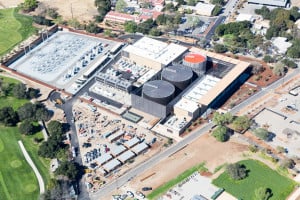
The Stanford Energy Systems Innovations (SESI) project’s new Central Energy Facility began full operation on March 24, eight days ahead of schedule. The plant will significantly reduce both campus carbon emissions and campus freshwater usage, according to executive director of Sustainability and Energy Management Joseph Stagner.
According to Stagner, Stanford’s old cogeneration plant, which was fueled by the combustion of natural gas, “used 25 percent of the University’s total freshwater supply.” Shutting down the fossil-fueled powered plant in favor of the Central Energy Facility will reduce water use by 18 percent.
“Of course with [California] Governor [Brown] asking everybody to cut 25 percent of their water use, by reducing most of that wasted water use with the cogeneration plant, we’re getting a real boost to help Stanford meet these water reduction goals during the drought,” Stagner said.
The project will save the University approximately $300 million over the next 35 years. Additionally, the new facility relies primarily on electricity instead of fossil fuels and will also reduce carbon emissions by 50 percent.
“By relying on electricity, this opens up the path for sustainability through any source of new, clean electricity that could be developed in the future,” Stagner said.
The $438 million project concept was approved by the Board of Trustees in December 2011, and construction began later in 2012. Stanford’s old cogeneration plant will be demolished to make space for a new neuroscience lab.
As part of a 2008 Energy and Climate Plan, Stagner reviewed technologies that the University could use to reduce carbon emissions. He found that 70 percent of the heat being wasted by the cogeneration plant – which has fueled campus since 1987 – could be used to fulfill 80 percent of the university’s heat needs.
He and his team then worked to develop a system in which heat produced by campus cooling systems could be recycled to heat the campus. In the past, much of this heat – generated by processes like air conditioning – was sent to evaporative cooling towers and discarded.
The Central Energy Facility is also operated by the Central Energy Plant Optimization Model (CEPOM), an automated system that calculates the heating and cooling needs of buildings across campus and delivers them efficiently. Both the facility and CECOM have received widespread attention from other universities and large commercial utility companies.
“Most people in the country think gas-fired cogeneration is the most efficient way to provide electricity to heat and cool a campus, and we think we can show that that’s not the case,” Stagner said.
Stagner encourages students and community members to come tour the facility, which was designed to both be functional and provide a learning opportunity. In addition to the docent-guided tours, signage and interactive electronic displays are being installed as aids.
Tours will begin on April 22 to kick off the Office of Sustainability’s annual Celebrating Sustainability Activities Festival. Spots on the tours can be reserved at SESI’s website.
Contact Alexandra Nguyen-Phuc at nguyenphuc ‘at’ stanford.edu